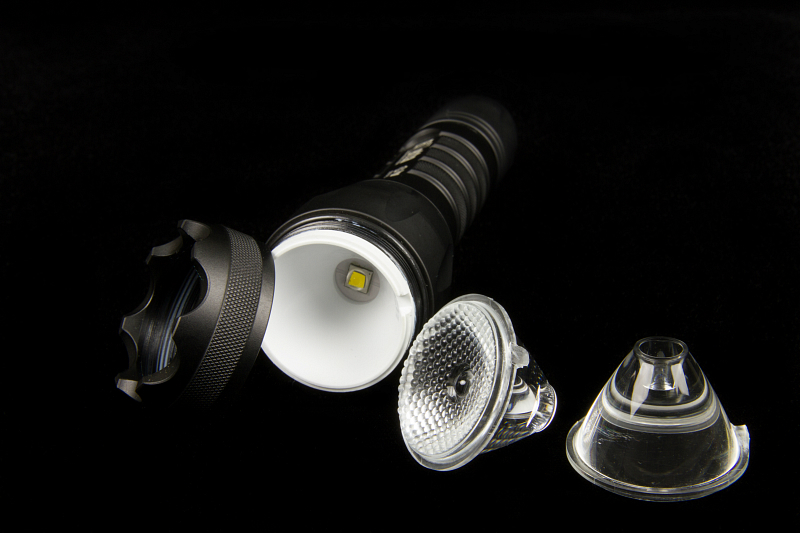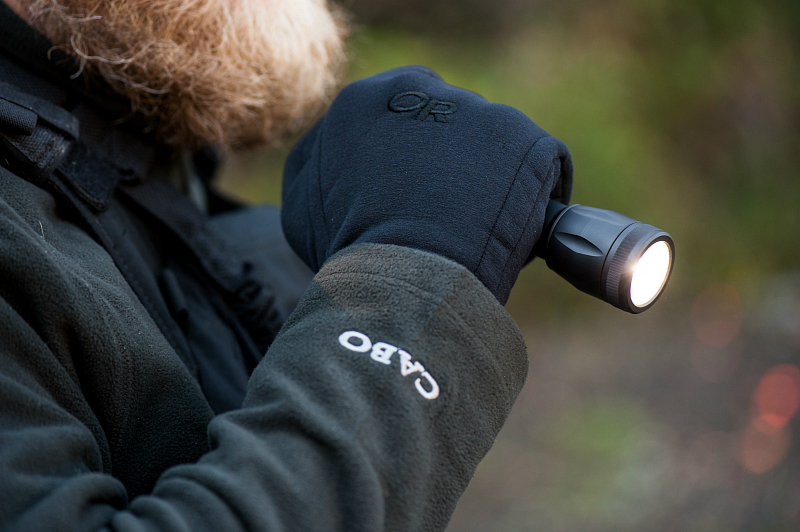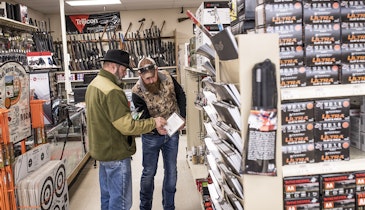With margins nearly five times that of firearms, many gun stores increase profits by offering a line of tactical flashlights. Make no mistake, these aren’t the cheapo, thin-skinned torches from your backyard camping expeditions as a kid. Today’s tactical lights are lifesaving tools designed for the police and military to use in high-risk situations when facing an adversary trying to kill them.
Criminals like to operate at night, but even during daylight hours, the sun can’t reach the interior of some buildings, so it’s not surprising that most police shootings occur in low light — whether at night or in some location where outside light cannot penetrate. Cops know that dark places hold threats, so they carry tactical lights at all times.
Retailers should consider that the average homeowner would also benefit from owning a tactical light. Suppose Mr. Smith is asleep at night and is awakened by a noise that has him reaching for his gun to investigate. To stay sneaky, he doesn’t switch on the lights, but instead creeps through the house looking for the source. He rounds a corner and in the dimness suddenly sees a figure who appears to have an object that resembles a gun in his hand. Is the intruder a burglar or the homeowner’s son returning from a late night out with only his cell phone in hand? This is one reason having a tactical flashlight and knowing how to use it is just as important as having a gun for protection.
Adding To The Bottom Line
Some retailers have found tactical lights to be a good source of income. Paul Sherman, purchasing manager for the Scottsdale Gun Club — a large, indoor shooting range and retail operation located in an upscale Phoenix suburb — says the store carries several brands. Fenix is the best selling brand, with an annual inventory turnover rate of eight or nine, followed by Streamlight at five or six and then, with only a fraction of those numbers, SureFire.
Pricing and dealer support, according to Sherman, are important factors that drive sales. The best selling Fenix model is the PD35 TAC priced at about $75, and the best selling Streamlight model is the ProTac 2L at about $60. Buyers include people who are deeply into the gun culture and own more than one tactical light, as well as those who simply want to see better when walking at night.
Sherman added that weapon-mounted light sales are only a fraction of hand-held sales. He attributes this to buyers not knowing the benefits of a weapon-mounted light and explained that if people knew more about the benefits of tactical lights in general, sales of hand-held models would also be better. He indicated that with so little knowledge, the buyer usually makes a selection based on price and high lumen output, while ignoring the other critical features and benefits of a good fighting light that are not found in the common utility light.
That’s why a knowledgeable sales staff that can educate the buyer would boost sales.
The Beam
Since the main purpose of the tactical light is to identify threats, the first critical feature for it to have is a high output light. Fifty lumens is considered by SureFire the minimum required to degrade an adversary’s night-adapted vision and temporarily blind him. But with advances in technology, many instructors now recommend a minimum of 200 lumens. And regardless of the light’s intensity, SureFire and other manufacturers say the beam should be flawless without dark areas that can confuse the user and appear to be moving objects as the beam is moved while scanning.
Ideally, the beam should also fade into darkness at the edges instead of abruptly ending with a hard edge. That’s because in a stressful situation, the eye focuses on the threat and people experience tunnel vision and don’t tend to notice objects in the periphery of vision. With a soft edge, objects or threats outside the main beam are more likely to be seen with peripheral vision.
To get a flawless beam with even coverage and soft edges requires some fairly sophisticated engineering and manufacturing techniques. Different manufacturers use different methods and naturally argue the method they use as the best. Early on in the evolution of the tactical light, most used a reflector with an irregular surface that resembles the texture of an orange peel. It is still being used in some lights and is easily identifiable.
Another method is total internal reflection (TIR). This is where no reflector is used, but instead an optical lens directs all the light forward in a smooth, evenly distributed beam. Elzetta uses this method exclusively and makes its optical lenses from solid acrylic like that used in shark tanks, while SureFire uses either the TIR method or the irregular reflector method. Both companies claim good beam range and smooth coverage.
Chris Spencer, a sales representative for Fenix Lighting, explained that his company uses a smooth, shiny reflector in conjunction with a Cree LED emitter that has a small, clear, rounded dome bonded to the front of the LED through which all light passes. Other manufacturers will say that a smooth reflector produces a beam with bright and dark rings or spots and a hard edge, but I did not detect any dark spots when using a Fenix TK16.
While not an exhaustive test, all the lights tested by Tactical Retailer, except the Elzetta, produced a hard-edge beam outdoors at night — so it’s important to check and compare brands and models. Ideally, the customer should project the beam into a dark area similar to the one in which they expect to use the light and determine for themselves if it is satisfactory. The customer should keep in mind that indoor light is reflected off walls beyond the hard edge of the beam and tends to illuminate areas that would not be illuminated outdoors.
The Switches
Another critical feature of a tactical light is a durable, lightweight body that will endure abuse. Generally, they are made of machined aluminum with very hard anodizing or high-impact polymer like the Nitrolon used in some SureFire models.
Additionally, a side-mounted switch is not always easy to find and activate, especially under stress, so the light should have a tail-mounted switch that can be easily found and be able to turn the light on and off instantly. Switches that have multiple functions such as “press once for low light, twice for bright light and three times for strobe” can be confusing under stress. Many recommend that simple on and off switches are much easier to remember and operate under pressure.
The switch should also have a “momentary on” feature so that when the switch is pressed the light is on, and when released the light is off. After all, a light not only helps the user to locate an adversary, but also helps the adversary locate the user. That being said, the light becomes a target, so it’s important to learn proper techniques for fighting with a tactical light.
The Batteries
Finally, the light must have a reliable power source that will retain power for long periods when stored. Most lights are powered by disposable lithium CR123A batteries because they produce more power than alkaline batteries and have a longer shelf life. In recent years, improvements have been made to rechargeable batteries, and now some tactical lights come with them.
A good, quality battery will have an internal regulator to prevent overheating, which can cause explosions and fires. SureFire recommends buying only SureFire batteries. Elzetta recommends using only U.S.-made CR123A batteries because Chinese-made batteries have been known to explode.
Anyone interested in self-defense is a potential buyer of tactical lights. The military and police have been using them for years because they see the value in being able to identify objects and threats that hide in dark places. Even hunters and homeowners who want to own a highly reliable portable light source can be customers.
Of course, the retailer must know his/her customer base and select products they desire, but don’t let this potential source of sales pass you by without taking a look at the possibilities.








